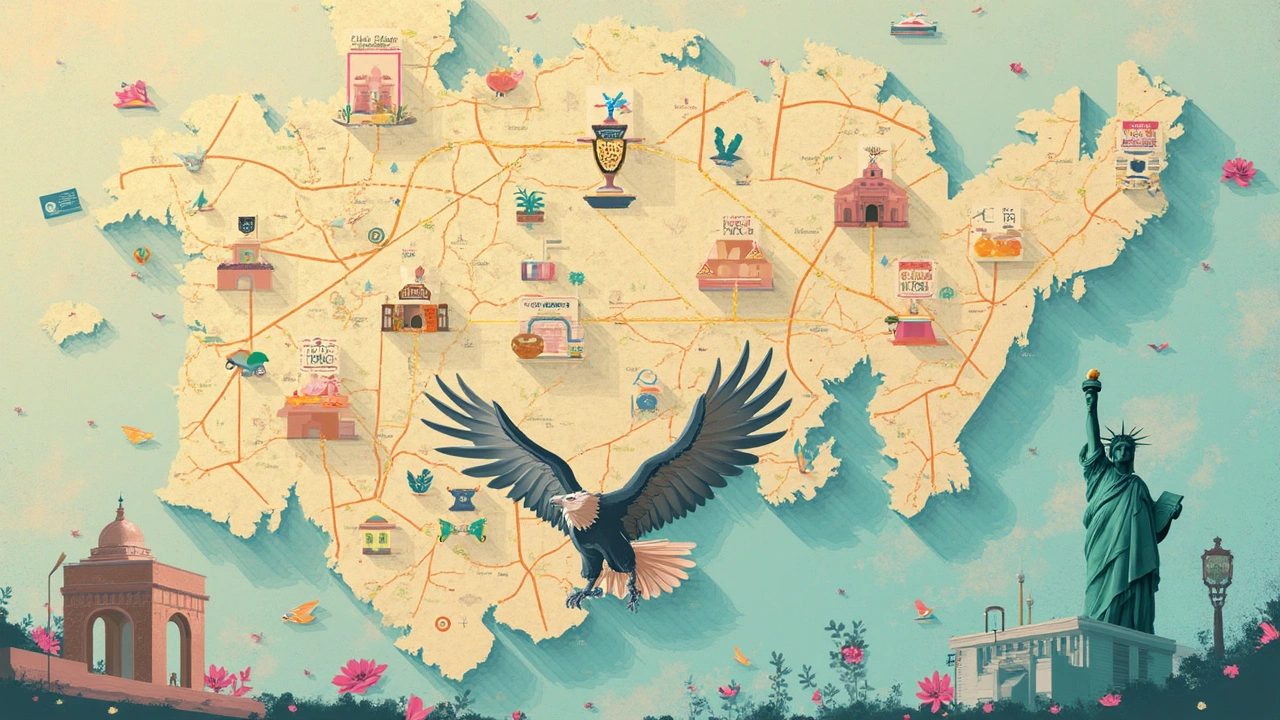So, you're in love with each other and thinking of tying the knot. But what if you're an Indian marrying a U.S. citizen? That's not just an emotional investment; it's a logistical puzzle too. From legal filings to merging worlds, it can get complicated but totally doable.
The first step is understanding the legal requirements in India. In India, marriage can either be registered under the Hindu Marriage Act or the Special Marriage Act. The cool part? Even if one partner isn’t Hindu, the Special Marriage Act has got you covered. It's open to anyone regardless of religion or nationality.
Once you're good on the Indian front, it’s time to tackle U.S. immigration. Get comfy with the K-1 Visa, often called the fiancé(e) visa. This lets your soon-to-be-spouse enter the U.S. so you can say “I do” on American soil. Yeah, it involves interviews and paperwork, but who says love is easy?
- Legal Steps in India
- Handling U.S. Immigration
- Cultural and Social Considerations
- Tips for a Smooth Process
Handling U.S. Immigration
Getting your love into the U.S. legally involves a bit of paperwork and patience. If you're marrying a **U.S. citizen**, you primarily deal with the K-1 or CR-1 visas. Let's break it down.
K-1 Visa (Fiancé(e) Visa): This is probably the first thing you’ll tackle if you plan to get hitched in the U.S. The K-1 visa lets your **Indian** partner enter the U.S. for a 90-day period. Within those three months, you must get married—no pressure!
- File Form I-129F: The U.S. citizen kicks things off by submitting a Petition for Alien Fiancé(e). This form proves the relationship is genuine.
- Foreign Citizen Visa Application: Once approved, the Indian partner applies for a visa from the U.S. Embassy or Consulate in India.
- Interview: After filing, an interview is next. Think of it like a relationship quiz show, but way less fun!
Don’t forget, after marrying, you should file for adjustment of status for a Green Card to start living happily ever after in the U.S.
If you’re already married, let's talk about the CR-1 Visa (Marriage Visa). It’s a bit slower than the K-1 but allows entry as a lawful permanent resident.
- File Form I-130: The citizen files a 'Petition for Alien Relative', essentially highlighting the family connection now that you’re married.
- Visa Processing: This involves processing at the National Visa Center and eventually a visa interview.
- Welcome Packet: After final approval, your spouse will get a visa packet they present when arriving in the U.S.
And finally, let’s not overlook some useful numbers: the processing time for a K-1 visa is usually around 8 months, while CR-1 can take about 12-15 months. Yep, they're lengthy, but planning ahead can save you loads of stress.
So, whether you’re looking at a fiancé(e) visa or just moved past "I do," understanding the immigration trail simplifies the romance of mixing nationalities. Keep calm and fill those forms!

Cultural and Social Considerations
Marrying across cultures is like mixing two different flavors in a dish. Sometimes it tastes amazing, while other times, it needs some adjusting. Being an Indian marrying a U.S. citizen means embracing each other's customs, festivals, food, and family dynamics.
First, let’s talk about festivals. Indians celebrate a plethora of festivals like Diwali, Holi, and Eid, which can be unfamiliar or overwhelming to someone from the U.S. On the flip side, traditional U.S. holidays like Thanksgiving and the Fourth of July are likely new experiences for the Indian partner. Embracing these events together can create a fun blend of traditions.
- Attend each other’s cultural festivals and understand their significance. It’s not about just showing up but soaking in the experience.
- Try cooking each other’s traditional dishes. Nothing says love like trying to make a perfect butter chicken together.
Family plays a massive role in Indian marriages. In India, marriage often involves not just two people but two families. On the U.S. side, marriages tend to focus more on the couple, which can be a shift for Indian families expecting close family ties to remain strong.
There’s also language to consider. While English might be common ground, colloquialisms and expressions differ. Indians might sprinkle their sentences with a bit of Hindi or Telugu, creating some fun confusion and lots of laughter.
Discuss and set clear expectations for where you’ll settle, how often you'll visit each family, and how you'll handle cultural differences. Communication is key here. Marriages thrive on compromise, and this is no different in an international marriage.
If you both work it out carefully, this cultural blend enriches your lives in ways you never imagined. Like sharing spicy Indian curries one night and enjoying a classic American BBQ the next, your life together can be as flavorful as you want it to be. Embrace the differences and cherish the uniqueness only a cross-cultural marriage can offer.

Tips for a Smooth Process
Navigating a marriage between an Indian and a U.S. citizen might sound tricky, but with the right moves, it can roll like butter. Here are some practical tips to make things a tad easier.
First off, paperwork is your best buddy. Make sure you've got every document checked and double-checked. For the U.S. immigration side, you need birth certificates, divorce decrees if applicable, and police clearance certificates, just to name a few. It’s not glamorous, but it’s necessary.
Then, there’s timing. You don’t want to be in limbo, right? Start the visa application process early. Those K-1 Visas? They can take around eight to ten months, sometimes faster, sometimes slower, depending on the tide (or, you know, current government processing times). So, planning ahead is the name of the game.
Also, communicate clearly with each other and a legal expert familiar with both countries' marriage laws. Legal jargon can be as confusing as another language. So, having a pro point things out can save a lot of headaches.
Cross-cultural marriage is not just about legal stuff; it's about blending two worlds. Make time to understand each other's traditions, foods, and values. Having honest chats about lifestyle changes or family expectations can make a world of difference.
If statistics are your thing, here’s a tidbit:
| Year | Number of K-1 Visas Issued |
|---|---|
| 2023 | 34,000 |
| 2024 | 33,500 |
Finally, patience is the unsung hero of international marriage. Things might move slower than you’d like (paperwork, approval, people catching flights), but every delay is a chapter in your story.
Nailing these bits can ease the whirlwind journey of marrying across borders. So, keep your cool, be organized, and enjoy the ride!
